[79FT]: Building Things |
 |
Exhaust Clamps
...shucks!
| On: | Oct 16, 2020 |
| In: | [Chickenhouse Charger] Electrical Rebuild |
| Time logged: | 9.0 |
| Tags: | 6781G, MA5 Charger, FWF, engine, exhaust |
About a week after engine start (yep, I took a break), back at the airport, and looking over the motor again, trying to figure out what the hell was that electrical type smell...
One theory formed...
You see, I hung the exhaust with copious amounts of anti-seize. I do have either a Grumman or a Cessna style exhaust, with 4 "stubs" (aka risers) coming off of the motor, and a "spider" looking setup hooking to them, joining all cylinders into a muffler under the front of the motor.
Risers go inside the main exhaust, and are held by clamps, engaging "beads" on the pipes.
So I thought, I'd hang the whole thing "loosely", so that individual cylinders will move, and use high-temp anti-seize to make sure it, well, doesn't seize up.
The working theory was that that anti-seize was "cooking" and produced a smell. I saw a lot of it blown out from around the clamps.
Another working theory was that maybe there was an insect or few stuck around the baffles or cylinders somewhere. There was one big wasp in there that I saw after the engine start - and smoldering insect carcasses sometimes smells just like burning wiring.
I know that last bit, because I spent insane amount of time, and got aggravated to no end, when I got this weird electrical burning smell in my old house. I was convinced I hit a wire when hanging some stuff to the studs just a few days before, and I literally drilled holes along every place where I hung things with a hole saw to make sure there were no wires.
There was one, but it wasn't pinched or damaged.
And all that was finally traced to a roach that died inside my air conditioner heat exchanger, right on a heat strip - heating season just started, the roach was dead and smoldering, and the AC was blowing that lovely smell all over the house. I later read a lot of fire department stories about similar situations of people freaking out and thinking their houses were on fire.
At any rate. My theory was either the wasp, or the anti-seize.
And my anti-seize blew out of the joints real well (ha!) - sooo.. I guess, the loose hanging exhaust idea was a no go.
And, by the way.
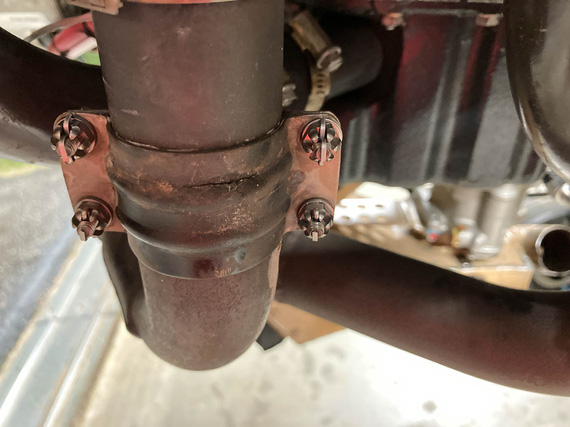
Crack!
Damn.
So the exhaust was taken off, again.
After quite some researching, here's what I found.
I had 1 3/4 risers.
Those clamps are ubiquitous Cessna clamps. Part number irrelevant - because...

Cessna clamps
Grumman also has 1 3/4 risers.
I was convinced I had a Grumman exhaust, because hey, what'd you take: a Cessna or a Grumman? :)
Those clamps are impossible to make to not leak. Forums confirmed by the way. Mr. John F. confirmed, too. Just think about them for a second - they will leak.
Grumman clamps are a bit different - they have this "liner" that is supposed to act as a gasket.
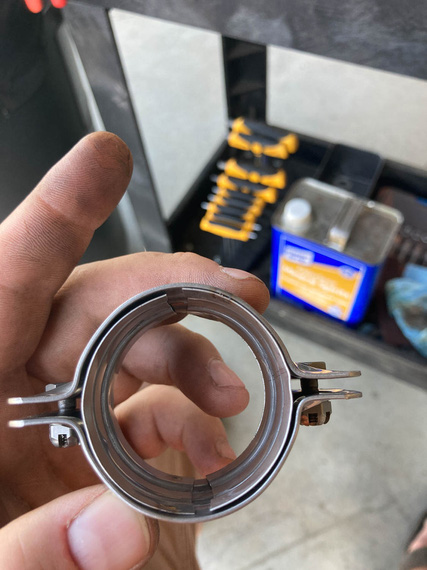
Grumman clamp
Yep, you guessed. I went Grumman. I don't have any Cessna friends. I have a ton of Grumman friends. You know where my heart lies.
Grumman book does not state anything about hanging the exhaust "loosely". It states to use Walker AcoustiSeal <part number here that doesn't exist anymore> (of course).
Mr. David Fletcher of Fletchair by the way confirmed that the exhaust needs to be tightened down, and that it's not a usual problem with it cracking due to differential movement of cylinder heads. Or rather, of course it will crack. But not all the time - it's perfectly fine.
We spent quite some time with Ben, figuring out the clamps (I was initially reluctant to fully close them because of the liner deforming too much), and AcoustiSeal. He helped find a catalogue AcoustiSeal with a different part number - 35959 - that is definitely within the temp range. I decided to use that instead of anti-seize. Researching a bit, it seems to "burn up" and "ash out" forming a fluffy, powdery type seal.
Cleaned every pipe, put on the new clamps with AcoustiSeal, and tightened them down. That was bad. Really bad. Torque was definitely excessive to close them, but I had to close them. It's obvious why, too - the OD of the pipe is 1 3/4; the ID of the clamp is 1 3/4, but the thickness of the steel liner is about 1/64 - so yeah. And my pipes aren't perfectly round, or smooth, either.
But they did close, and they did fine in the end.
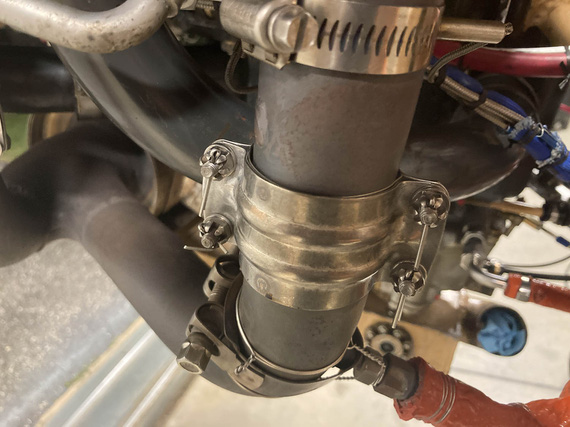
New clamps
I decided to try them. Worst case, I'd go back to Cessna style.
Also, cleaned up around the smoke oil injectors, and put AcoustiSeal there too. You can see one on the picture above. Re-safetied them a bit better too - the idea Glenn had was that if the main worm clamp failed, the safety wire will at least hold them in place.
And then, the other question came up that we spent quite a bit of time arguing over with Ben.
What's the torque on the Lycoming exhaust nuts?
It's not listed. Stud driving torque is listed. It's listed for vertical and geared motors in relevant sections of SSP-1776 at 160-180. Grumman book lists them at .. 110-140 if I recall correctly. The "by the book" application of "default torque unless otherwise noted" section of the "Direct Drive Engine" part would put it at 204-228. All inch pounds. So the range, depending on the source, would be 110-228 - a 100% difference. !!!
A lot of folks on the internet use the "default" - 204-228. A few were told to do so by Lycoming. When I torqued them, it felt... somewhat excessive, given that there's a gasket in play there too. There's no straight answer, really.
I settled on 180. Why? Grumman's book assumes "beaded" - not "no-blow" - gaskets. 180 is much closer to 204. 12% difference - within margin of error of a crappy typical torque wrench. And if mine is reading "high", I'll still be in the range listed for geared and vertical motors - which have the same cylinders as far as I know.
Yep, convoluted.
Anyway, second run yielded a very different smell - this time, of the regular "burning oil" sensation (which is typical for a motor that slowly weeps oil and throws it everywhere when shaking - that's the built in feature of spray lubrication and corrosion protection of your motor compartment! What? You weren't aware of that?!).
Much better. No blowouts of sealant anymore. No exhaust leaks I could discern.
... and, an oily fitting that I thought was oily after the first run because we used it to pour oil into the oil pump - but no, I confirmed a hose leak around the fitting of the only two hoses (oil cooler supply and return) I did not change.
Le sigh.
"Listen up gentlemen, or something's gonna happen that none of us wants to see. Besides that, you're (tickin') me off!"
-ORD ATC
Up ↑
Motor Start
...:)
| On: | Oct 15, 2020 |
| In: | [Chickenhouse Charger] Electrical Rebuild |
| Time logged: | 23.0 |
| Tags: | 6781G, MA5 Charger, FWF, electrical, engine, exhaust, alternator, fabrication |
And so, we're onto the race to the first motor run. I am writing this about a month later - according to the log, the motor was started up September 19, 2020.
But first...
Upfront
Finish mounting the starter was no problem: clean up the threads, clean up the studs, torque, done. Then, the alternator.
Belt tensioning... too annoying by hand, but it took me a while to stop trying and become sensible.
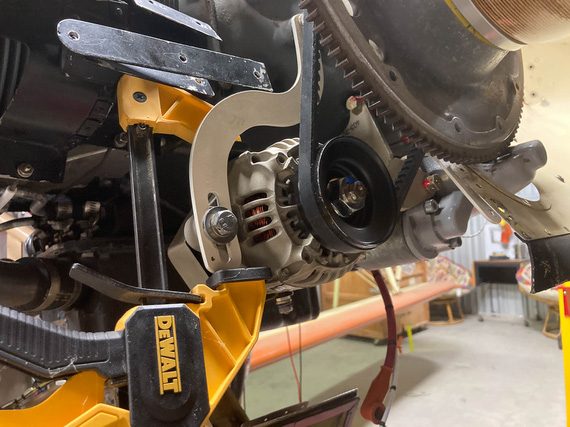
Belt Tensioning
You gotta safety two bolts over there, and I decided to make it nice: for the bottom (pivot) bolt, drilled a tiny hole in the bracket lower than where the alternator would be, and for the top bolt attaching the bracket to the motor... hmmm...
Somewhere on VansAirforce someone used a cherry rivet as a "hookup" point for the safety wire. I thought to one-up that, and use a short #8 screw - drilling it's head.
Frankly, I didn't think it'd work out.
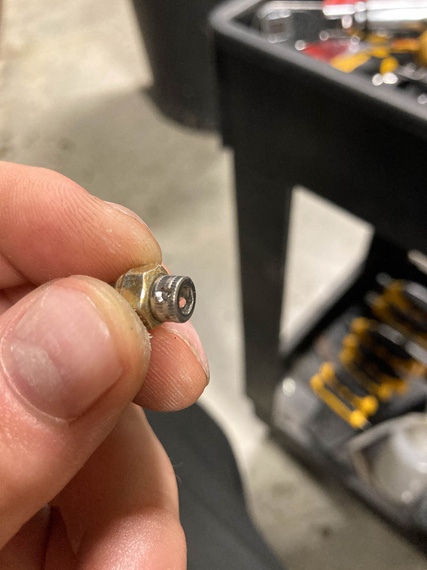
Drilled cap head
...but as you can see, it did.
So then, to the hole in the bracket. I needed a #8-32 tap.
Side, fun, story: quite a while ago I ended up bidding in a machine shop liquidation auction. Got quite a few nice things, including a very heavy duty bandsaw - and, accidentally, a massive cabinet full of tooling. Anything you could imagine: inserts, drills, taps, slitting saws, you name it. In all shapes and sizes. When we moved the cabinet, we emptied it into about 10 boxes, so ... I did have a #8-32 tap. In fact, probably about 20 of them. Question was, which one of the boxes were they in.
... apparently, in the one on the top. Hmm. This kind of luck is unusual.

Tap
Look at it carefully. Does it look like a regular tap we are all used to?
Didn't to me either.
So to researching we went.
Aha! "Threadforming" tap. AKA "Cold Rolling". So that's how they're done. Rolled threads are formed into the metal rather than cut; giving them superior strength. Basically, the tap shapes the metal, displacing it in the valleys and raising peaks.
Company that made these taps was advertising them for CNC milling. Well, what's a human if not a bio-CNC machine?!
Okay, problem number 2. I was pretty sure normal tap and drill chart values for hole diameters won't work; making too small a hole. Hmm...
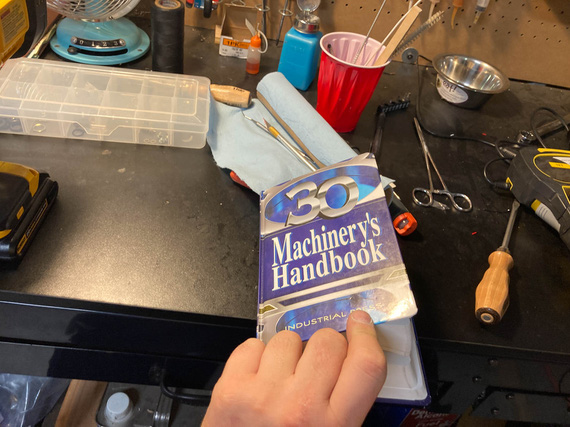
The Bible
Aha! "Ideal Theoretical Hole", and closest drill available charts are just what's needed.
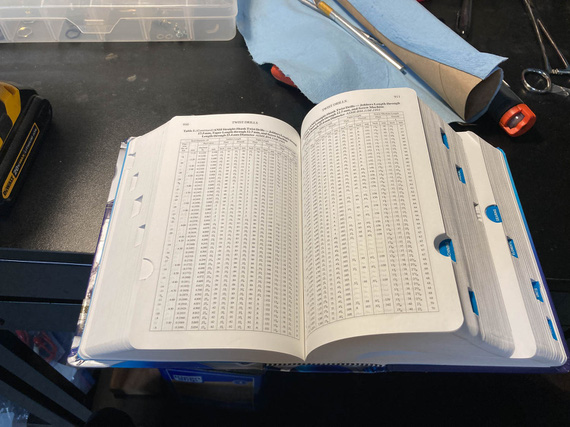
The Word
And with that, the affair was a non-event.
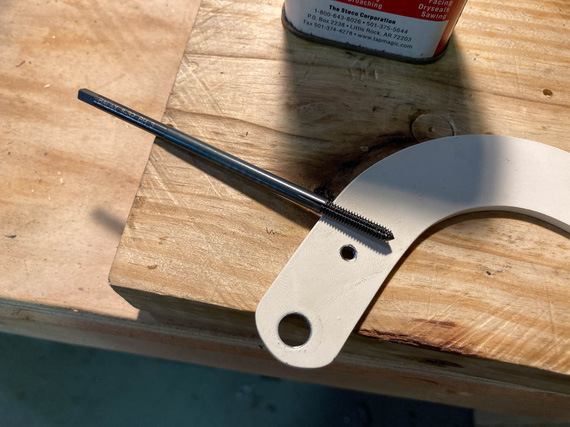
The Hole
Actually safetying was annoying - I had to try twice, because I had to use a hand-twister and you had to get the length just right.

Hand Twister
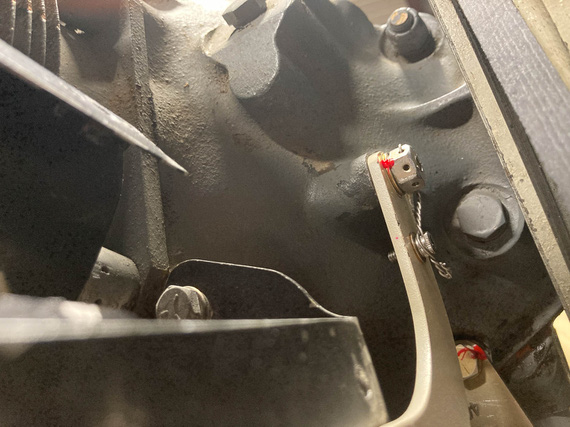
Safetied!
Airbox
That thing needed to be put back on, and carb final torqued with a new gasket. Cleaned it all up inside as much as I could, and had to cut a couple of special gaskets that I can't for the love of me figure out where to get (carb's base is different size from the top - and this is an "airframe" problem - read, "no standard part from Marvel or Lycoming I could find reasonably"). No problem. Used the same material Lycoming used for their gaskets, ordered from McMaster, and made me a couple.
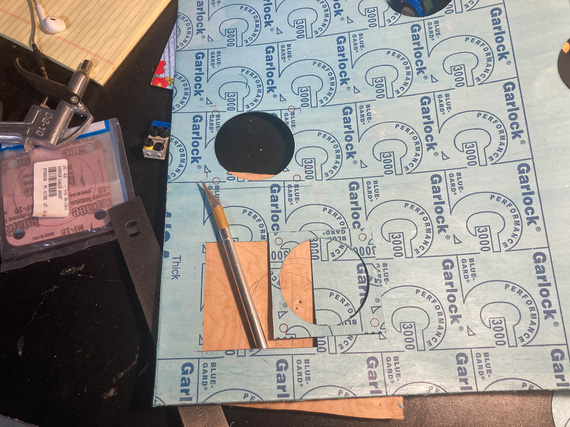
Cutting gaskets

Where they go
Perceptive will see the "airflow straightener". Glenn had it on when he put on the Rotec TBI, and in the times of my research of TBIs, I have discovered that some folks claimed they helped on carbureted motors as well. Well, it definitely won't hurt - aside from my having to do two gaskets instead of one. No biggie.
Carb
One interesting thing that happened. I had to drain the carb bowl of all the preservative oil, and flush it, so I took off the plug, drained it, and started putting it back in. Plug's an NPT thread with torque listed by Lycoming in SSP-1776 at 144 inch pounds.
Hmmm.. I noticed it was going in way deeper than it was in before, and way "harder" than when I took it out.
Hmmm.. Well, it's Lycoming, they know what the hell they're talking about. So in it went, at 144 inch/lbs.
But this bugged me. I think some other day I pulled out the Marvel's manual. 25-30 inch/lbs?! WHAT?!
Back to Lycoming. 144. Marvel (the makers of the carb)? 25-30. Damn it. Forums? Nothing interesting.
I finally figured it out. In SSP-1776, in the table for special torques, Lycoming lists the plug to have 3/4 pipe threads. Mine were 1/8 NPT. Lycoming's torque for those is 40-44 inch/lbs. Still higher than Marvel, but much closer now.
So, I undid the plug, that cut a bit of the tapered thread "deeper", of course. And put it back in, with the right torque this time.
Other Stuff
And then, minor stuff here and there. Cleaned and prepped spark plugs. Put the exhaust back on. Tightened things that had to be tightened. Charged batteries. Tied up everything hanging loose. Gave the plane a good look all over.
We were ready for the final day. There were a number of things I needed two sets of hands for, and I had just the man lined up.
Day X - or, September 19, to be Precise.
My buddy Mr. N. agreed to help, and be my observer and fireman (just in case). Mr. M. was extremely inquisitive about how we're gonna be putting out a burning airplane, and I had to explain a number of times that the goal of an exercise of starting a motor that's been idle for a year is not to have it go ablaze, and having a fire watch nearby is a part of prudence, not expectations. He seemed to have been disappointed. I would be too, if I was 5.
So, on a nice Saturday, we went to the airport.
First, drained all the pickling oil. Took off the prop (because we'd have to spin the motor to pressurize the oil lines). Put the fuel pump back on. Tightened all new fuel lines, and leak checked them. Mr. M. used my fancy "button with alligator clips" to turn it on. Put new oil in, primed the oil cooler and pump (and this is fun in this airplane, because there's no oil filler neck on the motor). Checked control cable travel, and final cotter pinned them. Checked brakes again (though we bled them when I finished fixing them up).
Then, came the pressurization, and purging of oil lines, time. Mr. M insisted that he wants to "press the button" - which would put +12V onto the starter contactor; bypassing my normal starting circuit (latter would make the left mag hot, and I didn't want that).
I told him to press the button and hold it and not let go till I told him to.
Now, starters with a motor with removed spark plugs are fast, loud, and annoyingly sounding. Mr. M. pressed the button. Jumped a bit. Grimaced a bit. He clearly didn't expect it. I didn't see it, Nick told me afterwards - I was watching the oil line. I yelled "Stop" when I saw the oil come out, and looked at Mr. M - who, at that point, was shaking and at the point of breaking down in tears. But! He didn't let go of the damn button. Man.
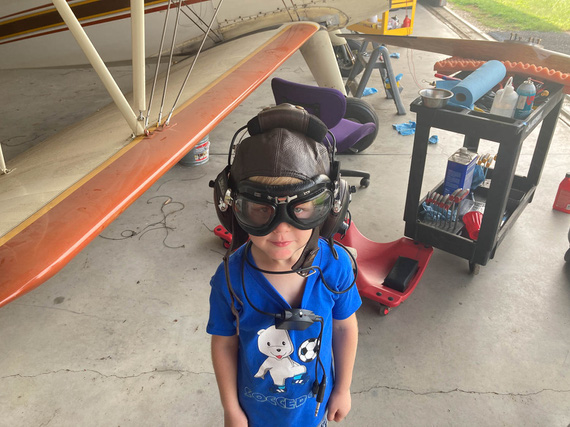
Mr. M
And that was that. Plugs went in, and we were ready, but broke for lunch, first. Mr M deserved his hot dog.
... back from lunch. Plane out. Wheels chocked. Brakes tested. Fire watch ready and instructed.
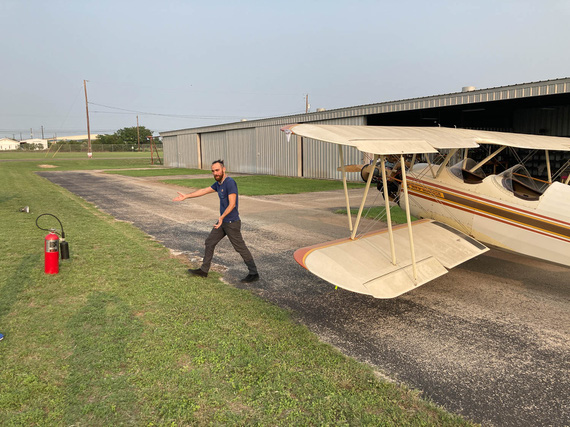
Final prep
... damn, that old Concord battery removed from the Cheetah years ago is weak and barely pulling thru.
... second try: no primer, so I have to pump the throttle a bit.
... she's alive!!!!!
I let the temps go up just a bit, and called N. He confirmed everything seemed to have been fine. We shut down, and went over every fluid fitting. All good.
Started her back up - I wanted to warm the oil to a reasonable temp and let her circulate for a bit, maybe 30 minutes - to get the juice flowing again.
On the second run, I revved her harder, and smelled something. Smelled like... burnt wiring? N. went around the engine, all wires, and everything he could see or think was close to being to a hot surface, or an electrical doodad. No signs of trouble.
We decided to proceed.
She ran just fine. I think we ran for about a total of 30 minutes. Shut her down, dragged her in. Went over the wires again - all of them. Nothing, all clean. There were no bad indications on any of the electrical instrumentation, either. So at that time, we left that as a mystery to be solved.
... and with that, we went home. We were tired.
Flying is better than walking. Walking is better than running. Running is better than crawling. All of these however, are better than extraction by a Med-Evac helicopter, even if this is technically a form of flying.
Up ↑
Exhaust...
...full circle
| On: | Feb 17, 2020 |
| In: | [Chickenhouse Charger] Electrical Rebuild |
| Time logged: | 17.25 |
| Tags: | 6781G, MA5 Charger, exhaust |
So finally, The Thing That Took Since November and That is Finally Done. Done?
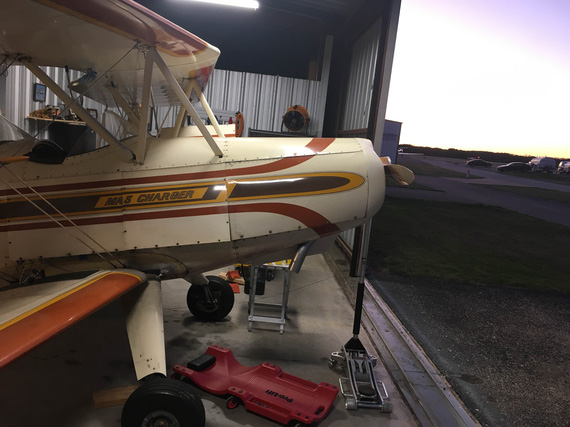
Tadaa!
Wait, what? The cowling's back on? Am I.. am I.. done?
Ha!
Nowhere near.
You see, one of the things I wanted to fix prior to putting the plane back in the air was this.

Wing root fairing
You're looking at the bottom right wing root fairing, all oily and burnt up, with paint flaking. It is bad. Really bad.
Why?
Because it is bathed in the exhaust, and because Glenn added the smoke system on top of that.
Here's the best couple pictures I have to illustrate what's going on.

Glenn's "Smoke On" picture

Old exhaust tailpipe
You can visualize what happens using the second picture. Black shading on the paper shows the original tailpipe. You can see how in the slipstream this will hit the wing root and the side, which is very much evidenced by the stains, oil streaks, and, well, burnt up paint on the fairing.
I wanted to fix this very, very, very much.
Research
As much as I am absolutely not afraid of electrical systems, I am very afraid of exhaust systems (and a few other things). I just don't know enough or have enough experience.
What turned up to be even worse was trying to find someone who does know what they're talking about. I poked around, and couldn't find anyone around or in our Chapter that knows this stuff well to be able to tell me "do this, and I got a TIG machine in the corner to weld up whatever you need".
So, I did the second best thing I could.
A couple years back, I met a gentleman at Oshkosh at our Biplane Forum gathering, Mr. T., who wrote a series of articles on motors, including exhaust.
He agreed graciously to listen to me (well, "read", technically) rant, and maybe guide me a bit.
So, to the drawing board!
I had to put the system back on, and hang the cowling back on the airplane as well, so that I could check everything in place.
When I took the exhaust system off, I plugged the stubs coming off of cylinders with duct tape. Big mistake!
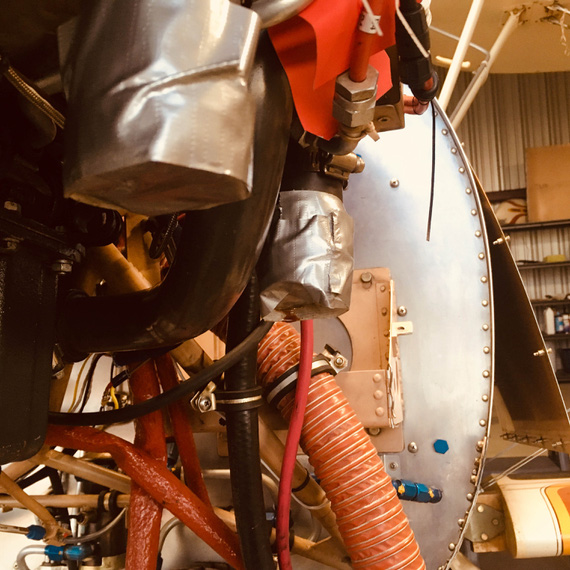
Duct tape on the stubs
Cleaning that crap off took GoofOff and about an hour.
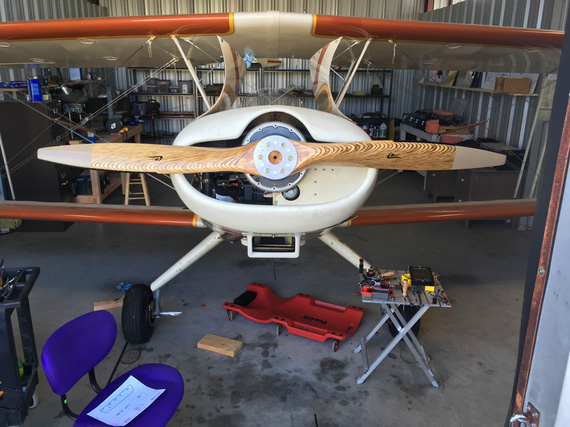
Old tailpipe
That's the head on picture of the old stub.
The first and the easiest possibility was, what would happen if I just extended it straight out?

Straight extension - head on
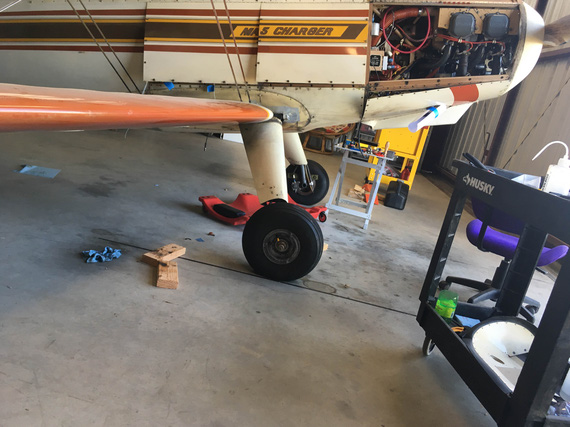
Straight extension - side view
I used a piece of paper to mock that up. Mind you, that'd be about a 10" extension! Lots of pipe, considering that the original tailpipe was maybe 16 inches long total.
It was obvious that doing this would move the exhaust outboard way more than moving it down. Why is this bad? Well, the bulk of it was hitting the aluminum side of the fuse and the plastic (okay, okay, fiberglass :) ) root fairing. Moved out this way, it would be hitting the fabric-covered leading edge. Somehow, that didn't sit well with me, and Mr. T. concurred.
So, I went on a scavenging run, and borrowed a nice piece of exhaust grade 3" SCAT from Mr. Dick G., my friendly neighbor, and attempted to mock something up with that.
Now that went way better!
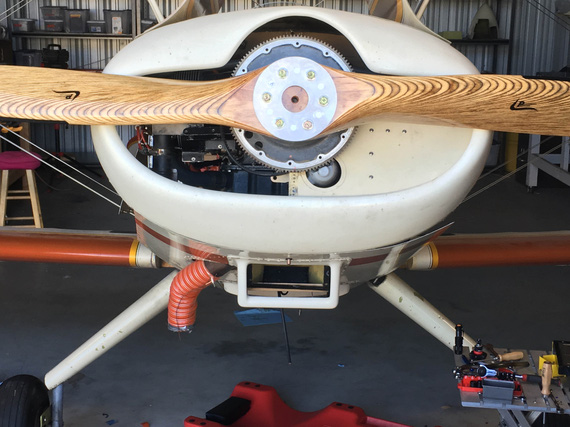
Approx 45 degrees
That moved the exhaust point downward, and I realized that I could play with it even more by bringing it closer to the airbox via cutting progressively more off of the old tailpipe (at this point with SCAT I haven't yet cut anything, because I was just playing and wasn't committed).
That seemed like a way to go. So, next step was to mock this up with a real 45 degree bend.
I got the cheapest slip-on 45 degree mandrel bend from Summit.
At this point, I had to commit, because using this slip-on would require some cutting.

Some cutting
I was committed!
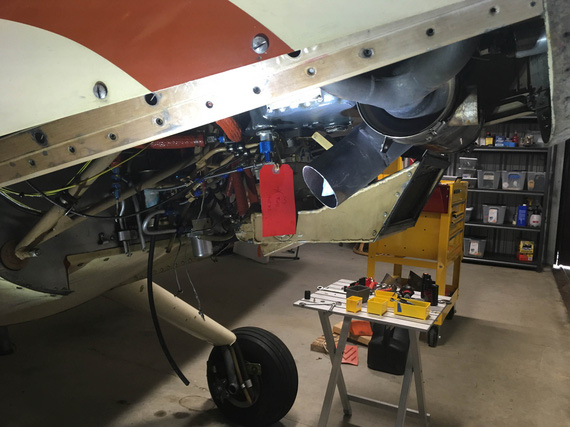
And some more cutting
And then, the fit with the bottom cowl on.

Front view
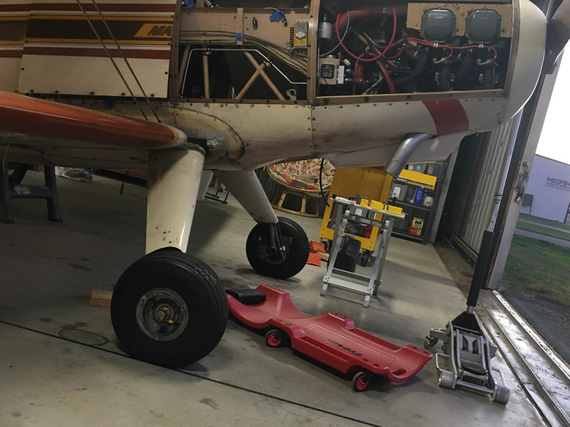
Side view
That looked just perfect! A total of about 8 inches of tube added overall, and the exhaust actually moved inboard, and way down into the slip stream.
All that was left to do was to buy the actual 45 degree bend I'd be using, and find a welder.
Unobtanium
I was looking around for welder who'd be willing and able while playing with the geometry. Asking around the airport didn't yield much.
Backup plan was Seth from Marioshop - the guy I take my cars to (his boss is a dragster, and Seth welded a lot of tube and exhaust - although, automotive, much thicker kind, with MIG).
I contacted folks from another EAA Chapter, the Waco 59, a great and dynamic EAA Chapter which I am also a member of, and scored - their very experienced Tech Counselor and metalworker Mike M. agreed to help me with the project. He welded himself, and also knew a gentleman that was "very artistic with his welds", as he put it.
I just had to get the material, jig it up to position it, and come over to weld everything up.
My tailpipe was 3 inches in diameter (jumping a bit ahead of myself, unusual for a motor of my size - too big). I measured .049 with my dial calipers, which translated into 18GA, and ordered the nicest shiny new bend from Summit. When it came, I realized...
It was the wrong thing.
Way thicker than what I had.
I think I mis-measured. Maybe I was asleep when I did it, maybe there was a lot of crud on the old pipe and I didn't pay attention, maybe .. but I needed 0.035 material. 20 gauge.
Quick Internet search - nothing.
More Internet searching - nothing.
I could buy all kinds of bends in smaller diameter tubing with 0.035 wall thickness. I could buy 3" tubing with 0.049 wall. I could not find 3" 45 degree bend in 0.035.
One company offered to sell me a straight piece. That was a good backup - we could've mitered and welded up the 45 degree bend in sections, but I wanted to see if I could find a bend. That same company offered to make me one - at a low price of about 600 bucks. Yikes!
Attempting to Hail Mary again, I posted on the Biplane Forum. Guys came back with a bunch of phone ##s of their contacts, and I started calling around!
Nope, nope, nope. I don't remember who it was, but one of the guys I called suggested contacting Custom Aircraft Parts.
A nice lady answered. "You gotta talk to Clint", she said, and transferred me.
Clint
Clint picked up. I asked if they could sell me the bend. Clint asked, "What are you trying to do"?
I explained.
He asked for pictures. A bit weirded out, I sent them over.
"I have two things I wanna tell you", said Clint.
"Buy yourself a bottle of soap and a nice rag".
"Be careful what you wish for".
Clit knew this 4-into-1 setup with a muffler in between very well. He told me that even with me trying to keep the extension as short as possible, I was running a risk of it cracking off at the muffler. Would it for sure? He didn't know. But the risk was increasing a lot.
I called my old friend and a Grumman aficionado Ben the same night. Grummans have this style mufflers (mine didn't by the way because it was sporting Powerflow - a very different system).
"Hey, do you recall welding cracked off tailpipes?"
"For sure".
Damn! Damn damn damn.
More mulling over ensued. I did not want to risk a tail pipe cracked off at the muffler. No way. That puts hot exhaust into a very tight cowling. On a biplane. With my having elevated fear of any in flight fire. Remember, I embarked on the electrical rebuild because I judged this airplane to be a flying fire hazard.
I talked with Ben more. I talked with Mike from Waco 59 more.
The attempted fix solidified.

Exhaust hanger
I would put a ball joint somewhere close to the muffler, with one end on the old pipe, and one end on the new extension that includes the bend. That ball would isolate the extension from the existing system, and allow them to move relative to one another.
I would then hang the new extension to the oil sump on some kind of hanger with a clamp - likely, a kind of tube with ends flattened and bent as required.
I sent this schematic to Clint. Well, no, not this one. This is a nice one I did when writing this post, over a picture I took when mocking up this solution. The one I sent to Clint was this. But, same idea.
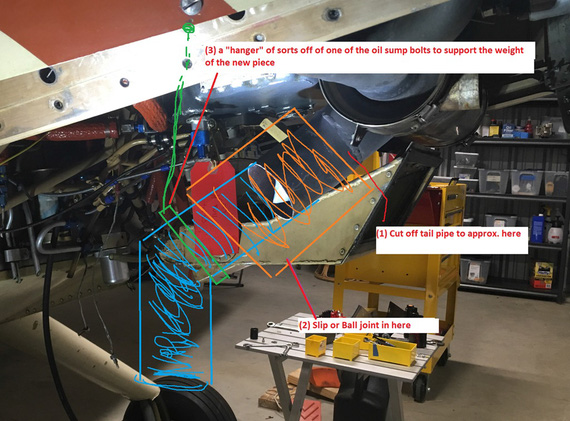
Schematic I sent to Clint
Clint's response? Verbatim:
Adding a ball joint and brace solves all of my concerns, you are free to do anything you want to the tailpipe. If you weld the bend on as your latest drawing shows, looks more reasonable. When adding a support brace it is imperative that it stabilizes the tailpipe to the engine, they must move together.
WOOT! Did I find a way to do what I wanted?
One thing to absolutely ensure was that the ball joint would fit.
We went back and forth a bit, me asking about dimensions. Then, I threw together a quick drawing of the widest part of the ball joint - the clamp holding it together - and tried it next time I was in the hangar.
No way. No way it hell it would fit. Airbox would get in the way.
Here's probably the best picture I have of why.
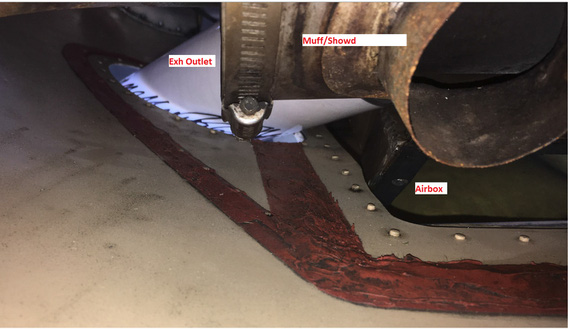
Clearances
That little triangle of "air" in between the cowling (bottom), exhaust pipe, and airbox is probably 1 inch on sides. No way a ball would fit in there. No freaking way.
So, what am I left with?
Putting it Back Together, the Way It Was
I gave up.
Called Clint on the way back from the airport, and asked him to sell me a straight length of pipe with a slip fit on one end.
Got it a week later.
Called Mike, got a contact for his welder, and went there.
The gentleman didn't like the fit - too loose - and wanted to make sure I pinned it exactly where I wanted (and actually, I should've done that in the first place, because the opening in the cowling is very tight, and just a degree of being off would make it interfere with the cowling). He also wanted me to clean all the gunk off.
So, back to the hangar, and fun fun fun with a die grinder, deburring wheel, wire brush... This 40 year old exhaust is gunky!!!
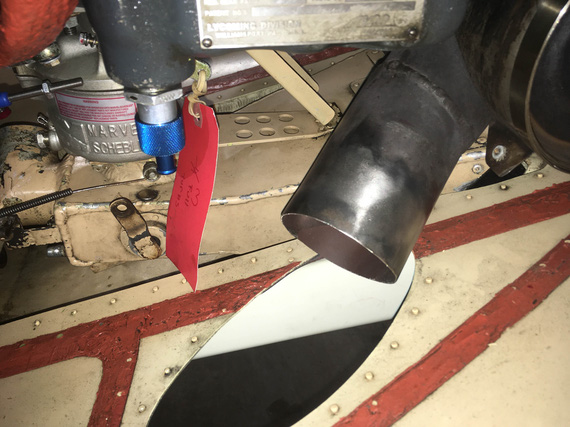
Back on for tailpipe fit
Put new section of pipe on, clocked it just right, drilled a couple of holes thru, and put in a couple screws.
Putting a nut on the inside of a 3" pipe about 10 inches "in" is .. exciting!

Nuts on the inside of the pipe
Then, pulled it off and put in more screws, to be absolutely sure that if it had to come apart, it would come back together in the exact clocking I needed.
Mike's welder fell thru, and that cost me a couple weeks at least. I focused on some other work - panels, compass, etc.
One of those days, I was on the phone with D. when a gentleman I didn't recognise walked over from the hangar next door housing a PT-19, and asked to borrow a hex key. When I hung up, I walked over to introduce myself.
"Hi, I'm M."
M.?! The M.?
Yep.
He's somewhat of a local celebrity, having built a ton of airplanes, and having worked on more. I met him on a couple occasions in passing, but not really, and I didn't remember his face when he walked over. He's a sheet metal and generally a metal guy. He was working on the PT-19's electrical (ha, fun coincidence, eh?)
A lot of hangar flying ensued.
He looked over the biplane. He told me of his building a replica Hughes H-1. Of his own design basically.
When parting ways, I asked, "Hey, do you have a welder by any chance?" Asking doesn't hurt right? "Yep, I got a TIG machine".
Ha! Of course :) I meant to ask if he knew a welder. But he was one. I should've thought of that myself.
He agreed to help me weld the damn thing back on, of course. He asked for me to clean the insides. It kinda made sense, too - you want full penetration when welding, and you don't want all that crud on the inside of the tube to "float up".
So, lots more of a die grinder time, with flapwheels, with a compressor barely large enough to run the damn thing for a minute straight.
Then, drove to M's shop, drooled over the H-1 and the MP-14 that he had on it.
And then, the final fit of the tailpipe to put it where it was when I cut it off.
We put the exhaust back on the plane,..
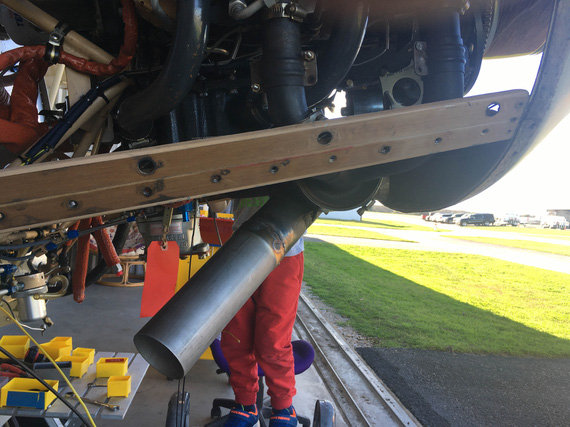
Back on the plane
...put the cowling back on, and I started fiddling around with things to try to figure out how to mark an even line to cut it off on.
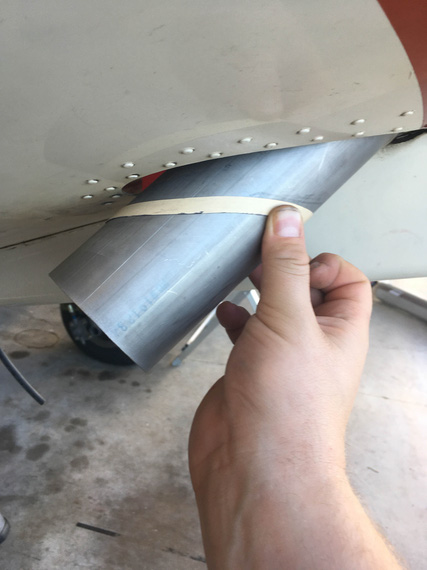
Rubber band maybe?
Rubber bands actually worked quite well. The kind I had was too tight, and I was playing with it trying to make it work and considering running to a nearby Office Depot, when I was offered a schematic to help guide me.
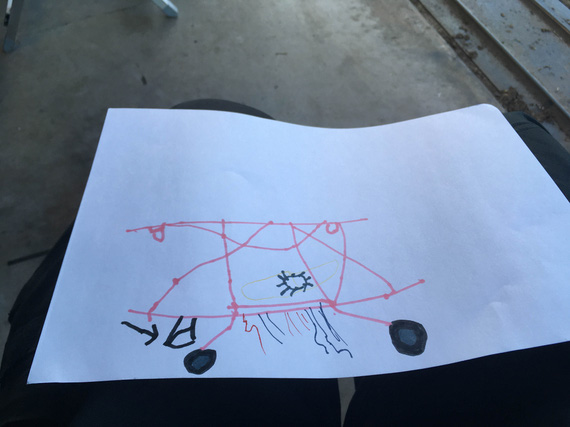
Exhaust cutoff schematic
But prior to emptying local stationery stores' rubber band supplies, I tried something else - pieces I cut off from the old pipe. Had to trim them a bit more to fit them over the new pipe, but that worked quite well in the end.
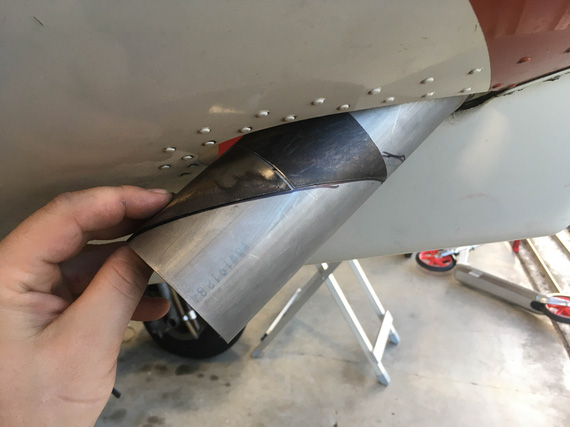
Using chunks of old pipe
Starting the hacksaw at this shallow an angle is... annoying? Is that the right description?

Starting a cut
I suck at hacksawing.
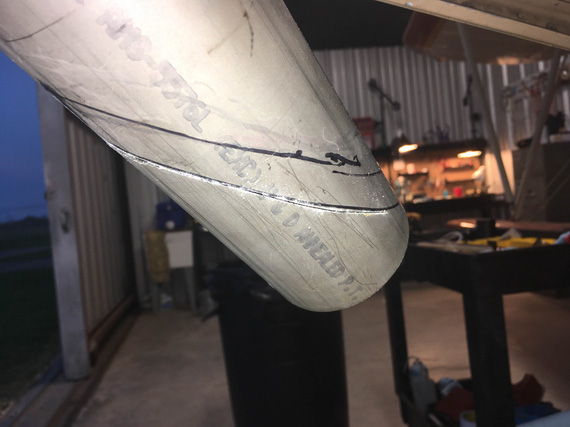
Ugly cut
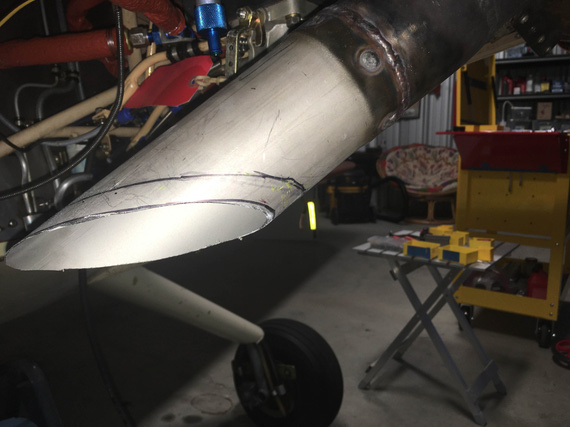
Ugly edge
My punishment? 30 minutes of grinding.
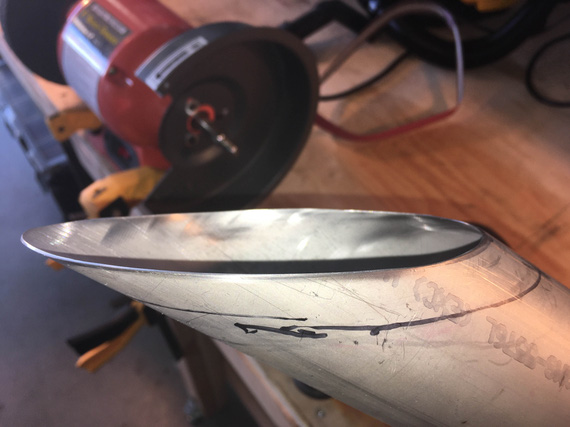
Finished edge.
And so, I am back to where I have started with this little project. My supply of rags is large, and my soap came in a 5 gallon pail (okay, okay, I do have some old stock is all :) ).
But, on the other hand, I think this is the Hump. It's when in a project, there are no more unknowns. You now just have to finish doing everything you've started.
Truly superior pilots are those who use their superior judgment to avoid those situations where they might have to use their superior skills.
© Copyright "79FT". All rights reserved. Feel free to cite, but link back to the pages cited.
This website only shows how I did things in my various projects. These pages are for information and personal entertainment only and not to be construed as the only way, or even the perceived correct way of doing things. You are responsible for your own safety and techniques.